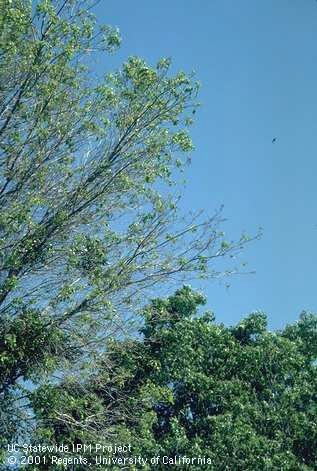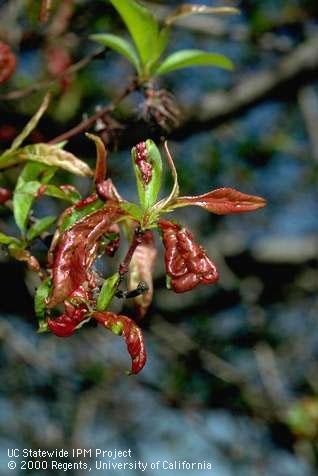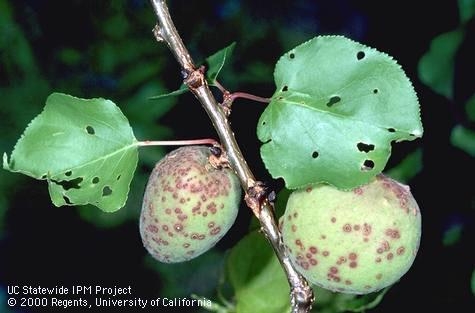After years of drought, we welcome rain in California. But we also recognize that rain can help spread a number of plant diseases. Rain and wind can splash bacteria and fungi from infected leaves, branches, and blossoms to uninfected parts of the tree. The fungal diseases anthracnose, peach leaf curl, scab, shot hole blight, and the bacterial disease fire blight can all be spread by rain splash. This ability to spread by water makes these diseases more common after a wet spring. With 2023 bringing quite a bit of rainfall and 2024 looking similarly wet, we want to focus on some common rain-dispersed diseases.
Anthracnose

Anthracnose affects many trees including almond, citrus, Chinese elm, and ash (Figure 1). In the spring, fungi produce spores on leaves and twigs that can be spread to new growth via water splashing. Under prolonged wet conditions, this cycle of spore production and spread can occur repeatedly. Anthracnose can defoliate trees, although it is not a lethal disease in most of its hosts. Once symptoms develop or become severe in a growing season, anthracnose can't be effectively controlled. It's best to rely on prevention of the disease by planting resistant varieties. For more information about identification and management of anthracnose, see Pest Notes: Anthracnose.
Fire blight
Pome fruit trees like pear and apple, and other related trees like pyracantha are often affected by fire blight. This destructive disease spreads in the early spring when rain splashes water from infected leaves and blossoms to healthy plant parts. Pollinators like bees can also spread the disease as they visit blossoms. Symptoms may not be noticeable until later when shoots and flowers shrivel and blacken. New growth is especially vulnerable to infection, so avoid heavy fertilization and pruning during mild wet weather.
The Pest Notes: Fire Blight contains much more detail on identification and management of this disease.

Peach leaf curl
Many home gardeners are familiar with the distorted, reddish leaves (Figure 2) caused by peach leaf curl, a disease that affects peach and nectarine trees. The fruit can also be damaged, becoming corky and cracked. Cool, wet weather favors the spread of the disease, but treatment must be started before the spring rains. Preventative sprays should occur after leaf drop but before flower buds swell. Resistant varieties are available to prevent this disease from occurring. Pest Notes: Peach Leaf Curl provides details about this disease and its treatment.
Scab
Various fungi cause the disease scab, which appears as spots and scabby blemishes on fruit and leaves. Apple scab is especially serious during wet springs and in the cool moist coastal areas of California, although these conditions are also conducive for development of other scab diseases. This disease can ruin the harvest of commercially grown apples and pears but in home gardens, some damage can be tolerated. Limit both apple and pear scab on backyard trees by removing and composting fallen leaves and fruit in the fall.
Information specifically about apple and pear scab can be found in the Pest Notes: Apple and Pear Scab. For more about other scab diseases, see http://ipm.ucanr.edu/PMG/GARDEN/PLANTS/DISEASES/scab.html.

Shot hole blight
Shot hole blight, also known as Coryneum blight, is caused by the fungus Wilsonomyces carpophilus. It affects almonds, apricots, and other Prunus species, as well as English laurel. Symptoms appear in the spring as small reddish spots that turn brown and drop out, leaving holes in the leaves (Figure 3). Fruit and twigs can also be affected. Since this disease is worsened by continuous leaf wetting, avoid irrigating foliage. For more information, see the UC IPM page on shot hole blight at http://ipm.ucanr.edu/PMG/GARDEN/FRUIT/DISEASE/shothole.html.
While you can't control the rain from spreading these diseases, good plant care and sanitation practices can help limit the severity. See the publications above as well as other pages on the UC IPM website to find out more.
[Originally featured in the Spring 2024 edition of the Home & Garden Pest Newsletter]